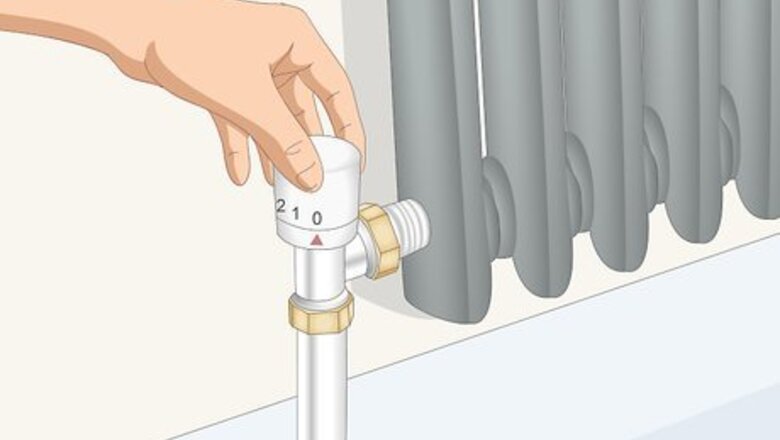
views
Turning the Radiator Off

Turn the thermostatic valve all the way off if you have one. A thermostatic valve is a small dial on top of newer temperature valves that twists to set the temperature, usually on a scale from 0-10. If your radiator has a thermostatic valve, turn it until the dial is set to 0 or “off.” The temperature valves are always on the bottom of the radiator, usually on the left. There are 2 valves on a standard radiator, a temperature valve and a lockshield valve. The temperature valve is usually on the left, and the lockshield is a symmetrical valve on the right. The lockshield valve locks the pressure in place and always has a plastic or metal cap on top. If you don’t have a thermostatic valve, you have a manual valve. The temperature valve is also called a control valve. It is used to regulate the amount of heat coming out of a radiator.
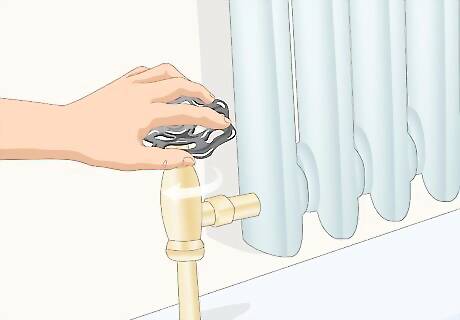
Use a wrench or your hand to shut off a manual valve if there’s no thermostatic valve. If there is no dial on your temperature valve, look at the top of the vertical pipe for a nut or handle on a vertical screw. This is the manual control for the radiator. Try turning it clockwise by hand to see if it closes. If it doesn’t, use a wrench or channel locks to force it all the way to the right to close the valve. There might be a handle on top of the manual valve. If there isn’t one, you can probably borrow a handle from a hose spigot. The bolts are often the same size. Manual valves are typically found in older radiators.

Close the lockshield valve with a wrench or pliers and count the turns. Find the valve unit on the opposite side of the temperature valve at the bottom of the radiator. This is the lockshield valve. Take the cap off of the valve and set it aside. Use a wrench or pliers to turn the nut on the screw sticking out on top all the way to the right. Count the number of times you turn the nut so that you can turn it the same number of times if you reinstall it.Tip: The temperature valve controls how much heat the radiator lets out at a time. The lockshield valve essentially controls the pressure in the pipes. Knowing how many times you turned it will help you keep the same pressure when you reinstall the radiator. While some radiators have a manual valve and some have a thermostatic valve for controlling the temperature, almost all radiators have a lockshield valve. There may be a screw connecting your cap to the lockshield valve. If there is, simply turn it counterclockwise with a screwdriver until it comes totally out. Then, remove the cap.
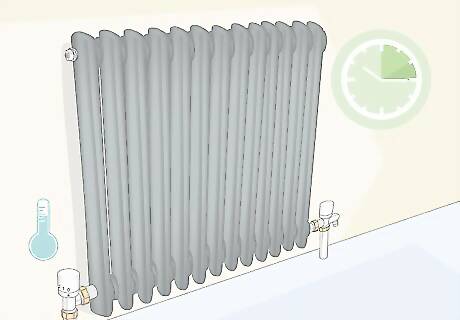
Wait 10-15 minutes for the radiator to cool if it’s hot. Before you start handling the radiator, let it cool off a little bit. The odds are pretty good that it will have cooled a great deal since you started closing the valves, but it can’t hurt to wait a little. You may hear your radiator crackle as you’re letting it cool. This isn’t anything to be concerned about.
Bleeding the Radiator
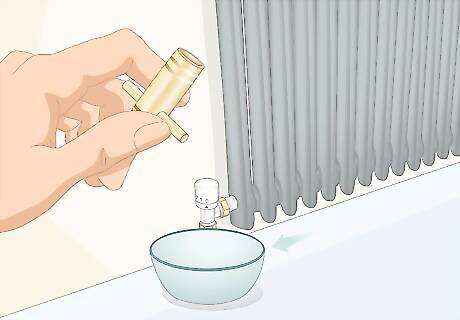
Get a radiator key and put a bowl under the bleed valve. Most radiators come with a key, but you can pick one up if you don’t have one at a hardware store. The radiator’s bleed valve is near the top of the radiator on the left or right side, and it has a little vertical slot on top of a cap. Put a bowl or bucket underneath the valve to catch the water that will come out when you bleed it.Tip: Radiator keys typically cost less than a few dollars. You may be able to use a flathead screwdriver if you don’t have a key though. The amount of water that comes out depends on when the radiator was bled last. It usually isn’t more than 2–3 c (470–710 mL) though. Bleeding is essential because it cycles the water out of the radiator. If you remove the radiator with water still in it, it may spill all over the place. Keep a cloth or towel nearby. Leave it over your shoulder or on top of the radiator. If the pressure is really high, some steam may shoot up out of the radiator when you open it. If it does, cover it with the cloth or towel.

Stick the radiator key in the bleed valve and turn counterclockwise. Hold the bucket up under the valve. Stick the key into the slot and turn the valve counterclockwise to open it. You may hear steam or clicking as the water begins to pour out of the bleed valve. If steam or water shoots out of the top of the radiator, hold the cloth over the top of the valve to redirect the water downwards while absorbing some of it. If you’re struggling to find the bleed valve, look on the sides of your radiator for a small cap with a single groove in it.
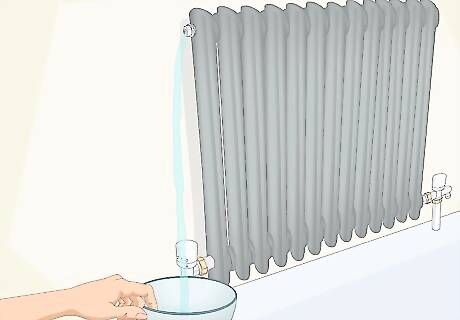
Catch any water that comes out of the bleed valve. As the radiator empties, move the bowl or bucket to catch all of the water that pours out. Let the radiator empty. Water may pour for as little as 10 seconds or as long as 5 minutes. It depends on how much time has passed since the last bleeding.
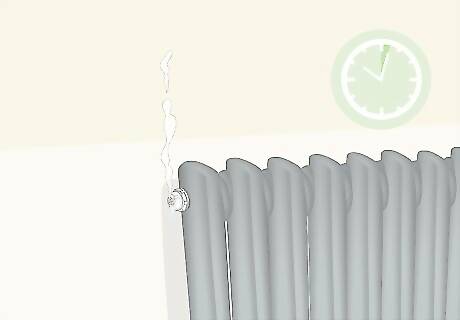
Give the radiator 2 minutes to let steam out after the water stops. Once water stops coming out of the bleed valve, wait 1-2 minutes. Even if you don’t see anything coming out, it’s helpful to let the steam and moist air escape the top of your radiator—especially if you aren’t going to reinstall it after you remove it. The air in the radiator isn’t toxic or anything, so don’t be nervous if it smells a little funny. It’s probably been trapped in your pipes for a long time.

Close the radiator bleed valve by turning the key clockwise. Put the same screwdriver or key back into the slot on top of the bleed valve. Turn it clockwise to begin closing it. Continue to turn it until you start to feel resistance and it won’t close anymore. If there’s moisture on the surface of the valve, pat it dry with a towel or cloth.
Unscrewing the Nuts on the Pipes
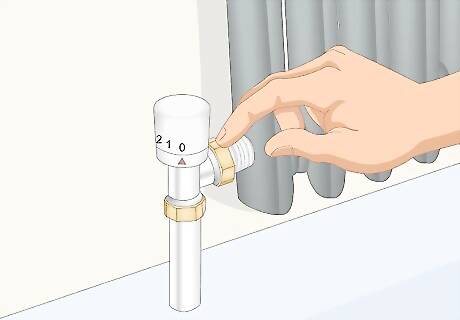
Find the nut in between the temperature valve and the radiator’s body. There are 2 pipes on the temperature control valve—a horizontal pipe coming out of the radiator and a vertical pipe coming out of your floor. Look for a nut on the horizontal pipe connecting your radiator to the other pipe.Warning: If the radiator isn’t mounted on the wall, it’s relying on the legs to brace it. Even if they look like they’re embedded in the floor, they aren’t. These radiators are typically really heavy and made of cast iron though, so you need help to move it. If you have a newer model that runs into the wall, there will be no pipes in the floor. The instructions are the same, but the vertical pipe will bend back into the wall.
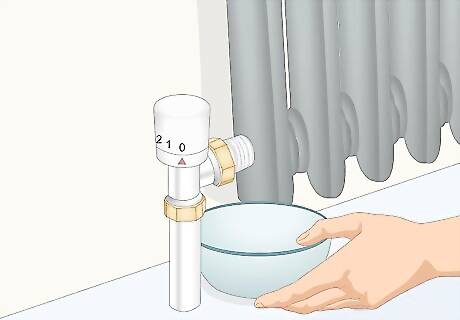
Put a bowl under the temperature joint that you’re going to unscrew. While you’ve remove a lot of the water, the pressure in your radiator has dropped, so there will be water at the bottom. Put a small bowl under the joint before you start unscrewing the nut to catch any water that falls. You can put a thick towel underneath the entire radiator if you want.
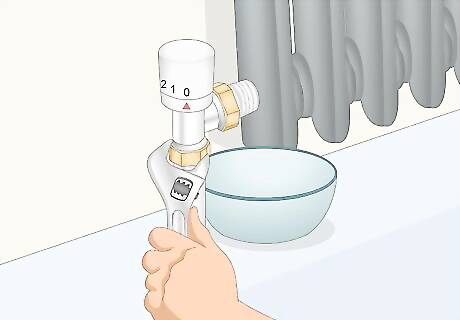
Keep the nut on the vertical pipe in place by holding it still with a wrench. It will be easy to accidentally twist the nut right under the valve on the vertical pipe. The valve is closed, but if you unscrew the nut on the vertical pipe, you’ll release the pressure. This could be disastrous. To keep the other nut from moving, grip it in place with a pair of channel locks or a wrench so that it doesn’t move when you unscrew the other nut. Regardless of whether you’re on the left or right, you’re always bracing the outermost nut and always unscrewing the nut in between the vertical pipe and the radiator.
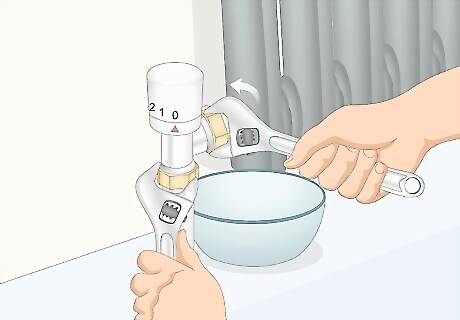
Use a wrench or channel locks to twist the nut in the middle. Place the jaws of your wrench or channel locks around the nut on opposite sites and grip it tight. If the nut is on the left of the radiator, start loosening the nut by pushing downwards while rotating the nut. If the nut is on the right side, start loosening the nut by pushing upwards. This nut likely hasn’t been rotated since the radiator was installed. It may be very stiff and hard to move. Do your absolute best to brace the nut on the vertical pipe while doing this without shaking the pipe around.

Loosen the nut all the way and let the valve drain for 2-3 minutes. Continue to turn the nut until it spins freely. When it loosens, drop the wrench or channel locks and spin it by hand to loosen it all the way. Pull the 2 pipes apart by moving the vertical pipe 1–2 in (2.5–5.1 cm) away from the radiator to let the pipe start draining into your bowl. You don’t want to yank on the vertical pipe, but if you move it around slowly, you won’t damage the pipes. If the vertical pipe is braced into the ground by a fitting, unscrew the nut on the opposite side and then rotate each vertical pipe away from the radiator to get the pipes off.
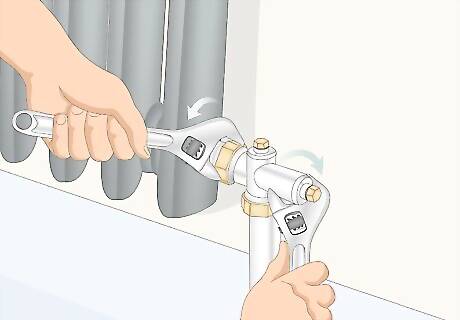
Repeat this process with the lockshield valve, twisting in the opposite direction. Once the water drains on the temperature valve, empty your bowl and put it under the junction on the opposite side with your lockshield valve. Brace the nut on the vertical pipe and then grip the horizontal pipe’s nut with your channel locks or wrench. Repeat the process on this nut and let it drain before taking it off. Twist in the opposite direction that you turned to get the first nut off. So, if you loosened the first nut by moving down, loosen this nut by moving up. Pull the vertical pipe away from the radiator to get it off. Let the lockshield valve drain for 2-3 minutes.
Pulling the Radiator Out

Pull the pipes coming out of the floor away from the radiator as far as you can. It may be kind of hard to completely pull the pipes apart, but you can definitely make things easier by pulling the vertical pipes away from the radiator to separate the 2 pipes on the bottom of each side. Pull each vertical pipe away from the radiator to create some slack on the radiator body. Don’t use any tools to pull the pipes out.
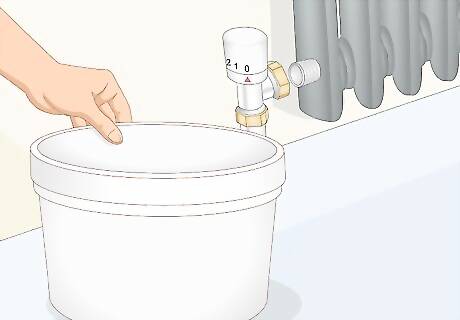
Set a bucket out on the floor to tilt your radiator in to. Once you lift your radiator up, tilt the opening into a bucket to completely drain the radiator. Set a large bucket up on the floor, but to the side of the radiator so that you don’t trip over it.
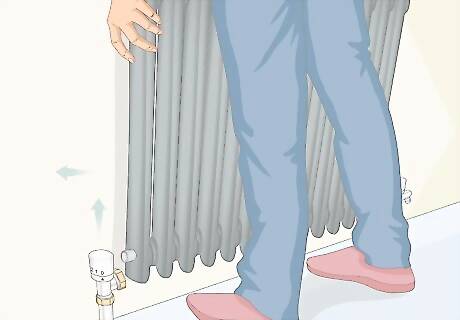
Lift the radiator up and slide it out while tilting the opening up. If you have a newer, thinner radiator, you can do this alone. If you have an older radiator, you probably need at least one other person to help you. Grip the radiator on both sides and lift it 0.5–1 in (1.3–2.5 cm) vertically to unhook it from the wall. While it is in the air, turn one side away from the wall while holding the other end in place.Warning: This can be kind of tricky to do on your own, especially if your radiator is older and kind of heavy. You don’t have a lot of room to raise the radiator and slide it. Go carefully and enlist help if the radiator proves too unwieldy. It doesn’t matter which side you pivot out first. Raise whichever side you pulled out first 1–2 inches (2.5–5.1 cm) though.
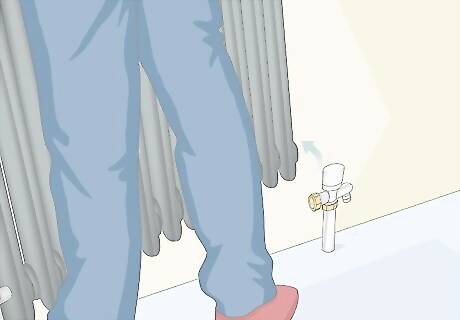
Tilt the radiator up and then slide the other side out. With one side pulled out, raise the open side a little bit to keep the water inside of the radiator. Slide the other pipe off by pulling the other end out and away from the pipe.
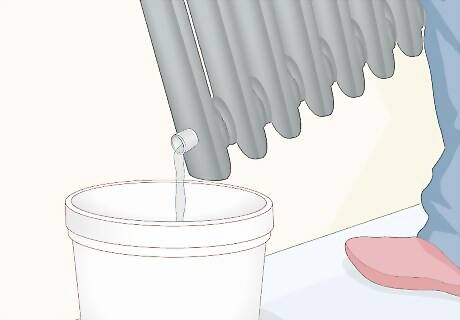
Empty the radiator into a bucket to empty any sludge at the bottom. As soon as you’ve gotten the radiator off of both pipes, tilt one of the openings down into your bucket. There will probably be some black or brown sludge that comes out of the radiator. Let this drain into your bucket. The sludge coming out of the radiator is residue from the coating on your pipes. It’s not toxic, but it will probably be gross. Try to keep it off of your floor, since the sludge stains can be really hard to clean up.
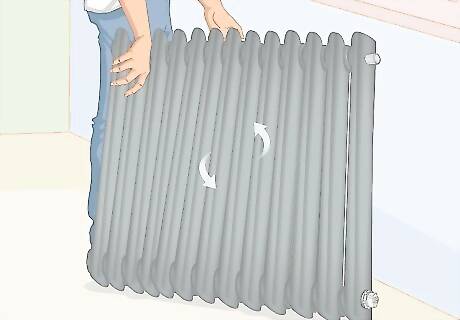
Store the radiator upside-down to keep more water from leaking out. Once your radiator is off, flip it upside-down so that the openings for the pipes are at the top. If you plan on storing the radiator off of the pipes for some time, keep it upside-down so that any leftover moisture doesn’t drizzle out on to the floor.



















Comments
0 comment